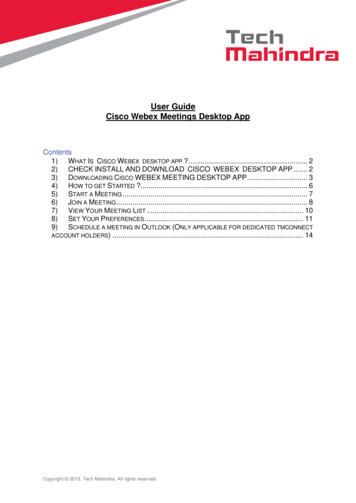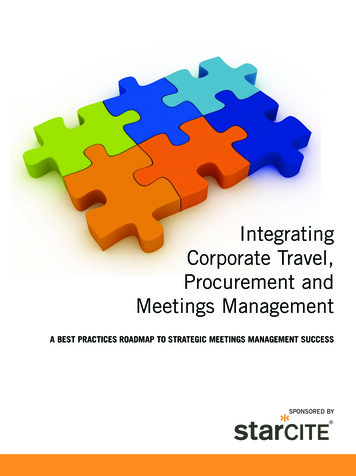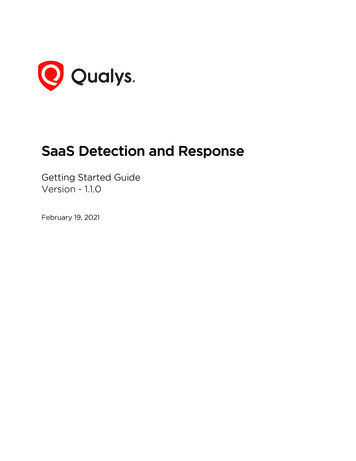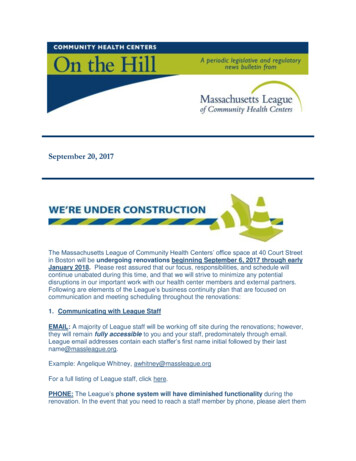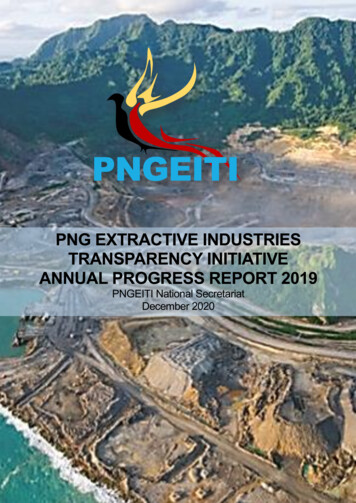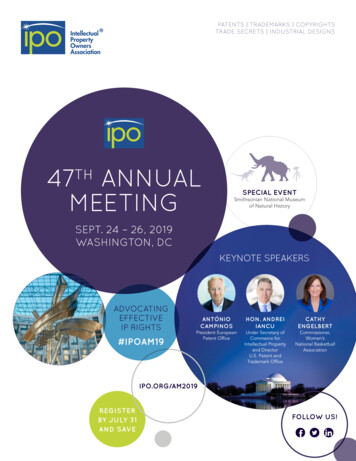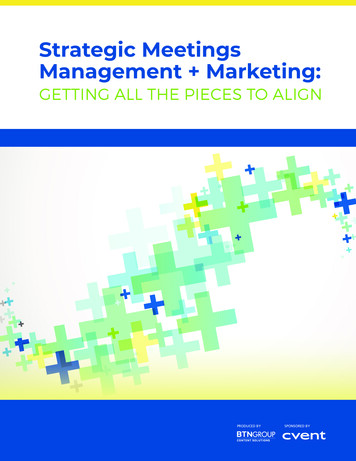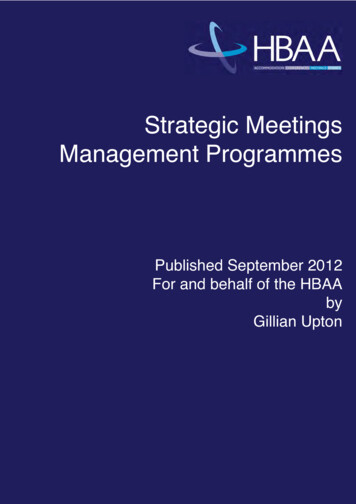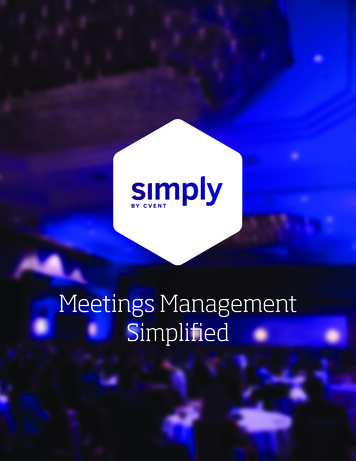
Transcription
Meetings ManagementSimplified1
It’s Easier Than You ThinkGBTA, ACTE, and a number of publications have shown the benefits of aStrategic Meetings Management (SMM) program. Many companies havesaved millions of dollars, reduced the risk of unmanaged spend, andincreased revenue through effectively managing meetings. Still manycompanies have not jumped on the bandwagon. Why?Stakeholders have shared a number of explanations over the years such asconfusion around the goals of an SMM program, what constitutes StrategicMeetings Management, and the difficulties in implementing a program. Asa result, many companies get lost, stalled in deployment, or remain in aperpetual holding pattern waiting for conditions to improve on their own.Today, the most successful programs are often driven by federal regulationssuch as Sunshine laws and Sarbanes Oxley regulations for publicly heldorganizations. The market consensus is that only organizations with a lot ofmeeting spend and complex needs should implement SMM programs. Butare these the right decision criteria to use? Absolutely not.The decision is simple. Ask yourself if there are inherent benefits to yourorganization by more strategically managing meetings, that is, will you:1. Be deemed compliant if auditedReasons to Implementa Strategic MeetingsManagement Program:1. Your company is concernedwith compliance – internal,government regulations, orother2. Your company seeks tocontrol the costs of meetings3. Your company wants toprovide a consistent and highlevel of service for meetingsto drive internal and externalcustomer engagement4. Your company is concernedabout employee safety andsecurity while traveling orattending meetings2. Save money or better leverage your meeting spend in negotiations3. Increase sales through more effective events4. Improve your relationship with customers5. Ensure the safety and security of your employees and customersThese areas are equally relevant to organizations with a few million dollarsin meeting spend, up to the largest companies with hundreds of millions inspend. There are certainly other reasons for implementing an SMM programsuch as efficiency and quality gains that may also play a role in the decision.In order to take that first step, or jumpstart a stalled program, companiesshould first identify their company goals and how their meetings and eventshelp achieve those goals.2
What are the Primary Goalsof an SMM Program?Reduce Risks / Increase CompliancePotential risk associated with meetings and events, includes regulatory risks,contracting and procurement risks, and the safety and security of attendees.An SMM program can help mitigate risk by ensuring compliance withcorporate policies and procedures. For example, directing events toappropriate venues, ensuring high-dollar contracts are reviewed and signedby an authorized signatory, or providing the information needed to locateattendees in case of an emergency or weather event.Reduce Costs / Spend More EfficientlyMeeting spend represents just over 1% of overall revenue for mostcorporations. These costs are often hidden in financial systems, leading toa largely unmanaged category of spend. A meeting request process (keyfor any SMM program) will provide greater control over meeting spend byidentifying meetings before they happen. By knowing which meetings arebeing planned, there are opportunities to consolidate or overlap meetings,package multiple meetings in vendor negotiations, and incorporate virtualmeeting components to reduce travel expenses. Additionally, standardbudgeting processes provide data to leverage negotiations with suppliersand analyze expense patterns to identify opportunities to optimize spend.Increase RevenueRegulatory Risk toEvaluate:1.Anti-bribery regulations, suchas the U.S. Foreign CorruptPractices Act and the UKBribery Act2. Industry specific regulations,such as the Physician PaymentSunshine Act, and theFinancial Industry RegulatoryAuthority guidelines / NationalAssociation of SecuritiesDealers Rules 1 Billionin corporate revenue 10 Millionin meeting spendWhether a meeting is internal or external, increasing the level ofengagement of meeting attendees leads to increases in revenue. Thestandardized processes and procedures of an SMM program ensure highquality meetings and events that result in employee loyalty or, in the case ofexternal meetings, deliver on business objectives, and develop brand loyalty.And as marketing events become more integrated into SMM programs, andlead management tools become more readily available, additional revenuewill be able to be attributed to meetings and events.Frost & Sullivan, A Survey of Meeting andEvent Planning Professionalsand Hotel Operators – 2013 CorporateMeetings Summit3
Achieving Your Program GoalsStep One:Solicit / Gain Management Buy-InSenior management often has a short attention span. Of primary importanceto them is understanding how your request aligns with their goals. In orderto succeed in obtaining high level support for your initiative you must dothree things:1.Focus on the Right Senior Managers and Stakeholders – this includesthe persons that have a vested interest in the success of the meetingsand those who hold the purse strings. This could be a number of C-levels,meeting, finance, and procurement managers, the VP of marketing, etc.Four Easy Steps toBuilding an SMMProgram:1. Solicit / Gain managementand stakeholder buy-in2. Write a meetings policy3. Design a sourcing strategy4. Implement a meetingstechnology platformTo sponsor the Meetings initiative, build a simple cost-benefit analysiswhich clearly articulates the value of the program. Successful programsalso call for buy-in from the people planning meetings, so understandtheir concerns and how the program will specifically benefit them. Giventoday’s pressures to do more with less, Planners are looking for efficiencygains while still delivering high quality events to their clients.2. Answer the Question – What Do They Care About? –”They” could bea wide range of stakeholders whose needs and areas of interest differ.Tailor your messaging to each stakeholder group’s specific concerns,which generally include: Increased profitability for the organization Improved return for their investment Reduced risk and air-tight compliance Enhanced operational efficiencies to improve employeeand customer satisfaction and to reduce costs4
3. Show Them Evidence That the Program Addresses Their Concerns –Include some specific examples of how the program will support theirinterests in making it a sound investment: Increased Profitability – demonstrate how an SMM program willgenerate more customer leads, and improve customer and employeesatisfaction and loyalty Improved ROI – outline how an SMM program contributes tomanaging both sides of the ROI ratio by increasing profitability andreducing costs Reduced Risk – educate senior leaders on the risks associated withcorporate meetings and events, and show how an SMM program canhelp mitigate those risks Enhanced Operational Efficiencies – illustrate the current stateprocesses and their impact on profitability and expense, and showhow an SMM program can introduce operational efficiencies toaddress those problemsDeveloping seniormanagementbuy-in requirestargeting the rightstakeholders: Chief Financial Officer Chief Compliance Officer Chief Procurement Officer Your organization’s Legaland Finance departmentsAnd showingthem how an SMMprogram: Reduces Risk Increases Profitability Improves ROI Enhances OperationalEfficiency5
Step Two:Write a Meetings PolicyA meetings policy is a set of rules developed by an organization for the procurementand operation of meetings. The most important component of a meeting policy isdefining what constitutes a meeting by outlining a formal meeting definition. Manyorganizations use criteria such as a minimum number of attendees, whether the eventis held on or off company premises, and/or a minimum estimated budget.Through policy, companies can impact spend by including guidelines around howmeetings are registered, which suppliers to use, who can sign supplier contracts,appropriate levels of services offered to attendees, and suggested spending caps. Awell implemented policy can result in incremental savings of between 10-15% for mostorganizations, and can also help prevent compliance issues by providing guidance oninteractions with government officials or health care professionals (depending on yourindustry) as well as spending limits for food and beverage and gifts.A meetings policy, like an SMM program overall, can be simple or complex based onthe needs of your organization. Table 1 shows eighteen possible topics to include, butonly the first nine are essential to achieve the fundamental goals of an SMM program.Every well-written policy includes a clearly defined scope which dictates who isrequired to comply, what types of meetings are included, where and when the policyapplies (geographically and/or organizationally). It is also important to clearly stateany policy exceptions or what is considered out-of-scope.1.Definition of a Meeting10. Group Air Travel2.Sourcing and Planning Procedures11.3.Meetings Technology Tool12. Familiarization Trips and Loyalty Programs4.Roles and Responsabilities13. Site Inspections5.Regulatory Risk Management14. Budget Approval and Payment Processes6.Duty-of-Care Guidelines15. Companion and Personal Travel7.Fiduciary Risk Management andSpending Guidelines16. Virtual Meetings8.Meeting Requests and Approvals17.9.Health and Emergencies18. Tax ImplicationsBooking AccomodationsSocial Responsability and Green Policy6
Step Three:Design a Sourcing StrategySourcing processes and procedures are the steps needed to identifyand select venues, negotiate and execute contracts. A good sourcingstrategy includes leveraging preferred supplier relationships by directingplanners to preferred vendors and negotiated rates. Use of key Nationalor Global Sales Office resources should be encouraged to ensure thebest position when negotiating with properties within their respectivechains. Developing standard terms and conditions for hotel contractingin a Hotel Addendum or standardized contract template and ensuringthat this information is conveyed to bidding suppliers is another key toensuring consistency in the procurement process. Identifying authorizedreviewers, approvers and designating signatory authority to specificresources will prevent risk associated with contract execution.It is also a good idea to outline the process to be followed when ameeting is cancelled. This includes how to leverage cancellation creditsby posting them for others in the company to take advantage of, and howthose credits should be applied when the space is re-used. When yoursourcing professionals and meeting stakeholders follow standardizedsourcing processes the potential savings achieved is in the 10-15% range.Step Four:Implement a MeetingsTechnology PlatformThe accuratecollection of keydata points resultsin comprehensiveanalysis, including: Supplier level reporting,which can be used toleverage negotiations andgenerate improved savingslevels Regulatory reporting,to document spend perattendee and overallcompliance to spendingcaps for travel, hotel, food& beverage, and gifts Crisis managementreporting, to determinethe location of meetingattendees based on air andhotel reservationsA meetings technology platform by itself is not enough to achieve thegoals of an SMM program, but it does support SMM processes such asmeeting registration, sourcing, budget management, and reporting. Atthe core of these systems is (1) the ability to document all meetings dataincluding event demographic information, suppliers used, and spendand savings information at any organizational hierarchy level, and (2) toenforce processes and procedures that were developed as part of thecorporate meetings policy.7
The right meetings technology system will allow for configurationbased on your unique business and process requirements andallow for development and growth over time.To achieve your SMM goals with meetings technology, all youneed are three basic implementation steps:Capture Meeting ActivityWith the correct technology provider, meeting request forms are completelycustomizable to collect desired information about meeting requester, meetingtype, and logistics (such as services requested, budget, etc.). Many technologytools will also automatically populate a master calendar to centrally locateregistered meetings and events. With just this first step, organizations will havethe tools needed to improve data reporting by easily pulling meeting requestdetails or an executive summary of meetings per division or by department.Automate Sourcing and BudgetingThe second step to implementing simple meetings technology is to automatethe sourcing and budgeting processes. This step can be done immediately, orin the months/years to come as your program gains adoption. It will automatemany of the processes outlined in your sourcing strategy and will provideadditional insight into spend and savings numbers on meetings and events.Increase Compliance and EfficiencyThe last step of implementing a simple meetings management technologyallows you to add additional automation and accountability tracking. Now is thetime to get more complex and automate key aspects of your meeting policy.Monitor the stages of your meeting lifecycle, reflecting not only how many totalmeetings occurred, but identifying peak planning times and understandinghow long a meeting spends in various stages along the way. Further thesourcing strategy by sending eRFP’s to preferred hotels or National SalesOffice’s (NSO’s), while also maintaining and utilizing cancelled space inventory.Improve insight into the budget through further customization, including savingsformulas to deepen the level of data analysis.8
SummaryIn summary we see that an SMM program does not have to be complex. Simplesteps and basic technology tools are all that’s needed to accomplish the core goalsof strategic meetings management. A simple and straightforward SMM programconsisting of policy, sourcing and planning processes and procedures, and ameetings technology system, can easily be rolled out. These three componentsare easy to implement, and can be accomplished in as short as three months.Content written byShimon Avish, PresidentShimon Avish Consulting LLCsmmconsulting.comwww.cvent.com / simply903-031314
should first identify their company goals and how their meetings and events help achieve those goals. Reasons to Implement a Strategic Meetings Management Program: 1. Your company is concerned with compliance - internal, government regulations, or other 2. Your company seeks to control the costs of meetings 3. Your company wants to
